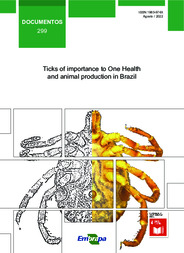Ticks of importance to One Health and animal production in Brazil.
Ticks of importance to One Health and animal production in Brazil.
Author(s): ANDREOTTI, R.; GARCIA, M. V.; PAIVA, F.
Summary: Ticks are ectoparasites belonging to the phylum Arthropoda and class Arachnida and are divided into three families: Ixodidae, Argasidae and Nuttalliellidae. They are necessarily hematophagous, parasitizing all classes of terrestrial vertebrates, and their main relevance is the ability to transmit infectious agents, such as viruses, bacteria, protozoa and nematodes, to their hosts (JONGEJAN; UILENBERG, 2004). Ticks have great importance to One Health, with a very important economic bias worldwide related to animal production (GRISI et al., 2014). More than 940 species of ticks have been reported across the globe, and approximately 10% of these have been recorded in Brazil. These ectoparasites (75 species) are distributed in two families: Ixodidae, which are known as hard ticks (51 species), and Argasidae (24 species), which are called soft ticks (MARTINS et al., 2019; MUÑOZ-LEAL et al., 2020; ONOFRIO et al., 2020; LABRUNA et al., 2020). Some species stand out in Brazil, either due to their economic importance, as is the case for Rhipicephalus microplus (GRISI et al., 2014), or due to their impact on public health, as is the case for Amblyomma sculptum, a vector of the causative agent of Brazilian spotted fever (BSF) (LABRUNA, 2009).
Publication year: 2022
Types of publication: Booklets
Unit: Embrapa Beef Cattle
Keywords: Argas Miniatus, Carrapato, Parasito, Produção Animal, Saúde Pública
Observation
Some of Embrapa's publications are published as ePub files. To read them, use or download one of the following free software options to your computer or mobile device. Android: Google Play Books; IOS: iBooks; Windows and Linux: Calibre.
Access other publications
Access the Agricultural Research Database (BDPA) to consult Embrapa's full library collection and records.
Visit Embrapa Bookstore to purchase books and other publications sold by Embrapa.

